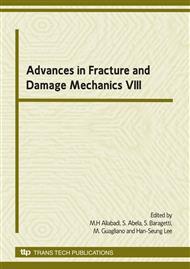p.309
p.313
p.317
p.321
p.325
p.329
p.333
p.337
p.341
Fatigue Resistance and Crack Initiation Mechanisms in High-Thickness Aircraft Al-Alloy and Steel Sheets after Water Jet Cutting
Abstract:
Water jet cutting is an advanced technology of separating and machining materials. It is well known, however, that fatigue properties are particularly strongly affected by surface conditions and quality of surface layer. Water jet cutting was applied to two types of aircraft sheets, namely Al-alloy sheet of fairly high thickness 50.8 mm and steel sheet of thickness 25 mm. Fatigue resistance and crack initiation mechanism of the materials after the cutting were compared with those studied using a reference batch of specimens manufactured by fine milling and grinding, respectively. Character of surface damage caused by water jet cutting resulted in a considerable reduction of fatigue strength in comparison with milled or ground surface, respectively. The results are evaluated considering effects of microscopic character of surface conditions, like numerous micronotches caused by the technology used, on fatigue initiation process, as well as effects of subsurface inclusions on fatigue crack initiation and early growth.
Info:
Periodical:
Pages:
325-328
Citation:
Online since:
October 2009
Authors:
Price:
Сopyright:
© 2010 Trans Tech Publications Ltd. All Rights Reserved
Share:
Citation:


